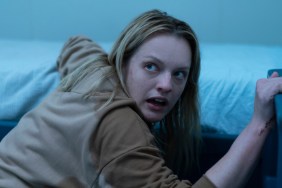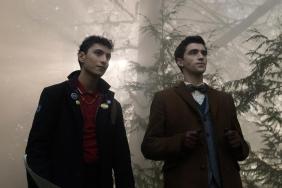One of the movies that impressed us the most at last year’s Toronto Film Festival was J Blakeson’s debut The Disappearance of Alice Creed, a dramatic crime-thriller about a kidnapping that doesn’t go as planned.
Sounds like a lot of other movies you’ve seen, doesn’t it?
Sure, one might think so from reading the simplified plot synopsis, but from the very first minutes of the movie, it’s obvious you’re watching something special, as two men, played by Eddie Marsan and Martin Compston, silently and meticulously make all the preparations necessary for their planned kidnapping, leaving nothing to chance. A few minutes later, their victim, played by Gemma Arterton, is dragged kicking and screaming into the environment they’ve created, and the film proceeds to go into places you’ll never expect, as it explores the intense relationship between three unwitting individuals brought together by this crime.
Blakeson had mainly been working as a screenwriter in England for the past few years, having written the recent DVD release horror sequel The Descent 2. Even with his lack of experience behind the camera, it’s evidently clear that this is an incredibly smart and thoughtful filmmaker, able to create a visually exciting film even with much of it taking place in one location and involving just three actors. Beyond Blakeson’s distinctive style, much of the film’s strength lies in the amazing performances, whether it’s Marsan playing an unrelenting villain with a secret, Arterton displaying a few new emotions from her repertoire, and Compston, the relative newcomer of the group, doing a fine job keeping the other two actors on their toes.
Maybe it shouldn’t be too surprising that Blakeson’s movie has been called “masterful, outstanding and riveting…” — oh, wait, that was what we said about the movie in its brand new teaser!
With its U.S. premiere at the 2010 Tribeca Film Festival coming just a week before its theatrical debut in the UK, ComingSoon.net had a chance to sit down for an interview with this talented new director.
ComingSoon.net: Is this something that you’d been working on for a long time before you finally got to make it into a movie?
J. Blakeson: Not really. I’d been a screenwriter for eight or nine years, it was eight years before this got off the ground. I got into the industry to be a director; I wanted to be a director, not a writer. My dad’s a writer and I’d seen how sort of frustrated it made him over the years. (laughs) So the one thing I didn’t really want to be was a writer pretty much, so I made a couple of short films at university and I got an agent straight out of the university when I was 21 off the back of short films and a script I’d written. Then I thought, “That’s it. I’m gonna be a huge international director within like six months.” Obviously that’s not how it works. (Laughs) I moved to London with the intent of becoming a film director, but I couldn’t direct any films because I didn’t have any money and I didn’t have any contacts, you know, back then you didn’t even have decent cameras, you had Hi 8 cameras, and back then, you had to have a video editing suite. Nowadays it’s much easier. So the only thing I could really do was write scripts then try to persuade people to give me enough money to make them on 16mm, because my two short films from university are on 16. Then I was sort of a victim of my own success, because I kept on selling (my scripts) and no one wanted me to direct them. Because I sold a few without being attached as a director then I was suddenly a screenwriter and when you’ve got to pay your mortgage, being a screenwriter is better than nothing. (Laughs) You think, “I’ll use my contacts and I’ll get to direct.”
CS: Have you always been writing for film or did you do some television stuff as well?
Blakeson: Mostly film. I did a little bit of TV, but nothing particularly…
CS: You think that most screenwriters go to LA because that’s the place to be for screenwriters.
Blakeson: Sure. I mean, there’s a small industry in the UK, but once people know you, everybody knows you because it is so small. I got a lot of meetings when I was about 21, 22 and then people realized I was about 21, 22 and they wouldn’t give me control because I was so young. (Laughs) Then I wrote a script that I sold, which is a teen movie that I was eventually attached to as a director. In between me writing that and being attached as a director and almost getting it made I’ve then worked on like, three or four other scripts and some of them with a writing partner called James (McCarthy). We wrote a big conspiracy thriller for Working Title that they never made, then we wrote “The Descent 2,” or we wrote some of it and then it got rewritten by James Watkins. As I said, I got very close to directing my first feature with this teen movie that I’ve been working on for years (Laughs) that got very close and then never went. Just at the 11th hour it fell apart, so I decided I wasn’t gonna try and do it through the system, because by this time, there were red cameras and laptops and Final Cut Pro. (laughs) I’d made a couple of other short films and it’s like, “Well, I’m just gonna write one that I can do myself.” So I wrote something, I can set up rules and stuff that have been contained. I set basically only two locations for most of the film, only three actors, because I could get three actors. Then doing little tricks like block up the windows which is sort of like a narrative function, but it also means that like in Kevin Smith’s first film, you can shoot day for night for day or whatever, it doesn’t matter. So you just block the windows up.

CS: I wanted to ask you about that because this is really an ambitious film, but really, it’s only two locations and three actors, and I wondered if you planned that from the beginning.
Blakeson: Yeah, well that was done just for budget reasons originally because I was just gonna do it on my own in my own apartment. I had an apartment and I figured I could go on EBay and buy a van, so that’s basically two of the main locations for the whole thing. You know, they had things over their heads quite a lot, which means that if we only had a name actor for a few days, we could shoot all of their scenes and then do everything else with stand-ins. Because I had made these no-budget shorts, so I was sort of coming from there. Luckily I didn’t have to do that, because once I had the script written and my agent read it, she said, “Well, we’ve gotta show this to people and then it was out.”
CS: You’ve got three great actors and in the case of Eddie Marsan and Gemma Arterton, you got them at a great time right before their big movies came out. Were you able to get them just based on the strength of your script?
Blakeson: Yeah, absolutely. I mean, Gemma wants to do it because of the script. Our casting director is a woman called Lucy Bevan, and she cast Gemma in “St. Trinians”; that was Gemma’s first film role. She’d been friendly with the casting director since then, so that was our kind of contact and it was just purely the script. She loved the script and she says these are the kind of films that she watches and she likes. So it’s the kind of thing that she really wanted to be in, coming off “Prince of Persia,” which was like a six-month shoots, massive, 25 takes of everything, you know what I mean? Coming to do like four weeks in the Isle of Man in one set. I think she felt that it was the complete antithesis and really refreshing. With Eddie, Eddie had made two films, he had two roles in small films the company had made in the same year. So he was in “Me and Orson Welles” which the company that made my film made, and “Heartless,” a Philip Ridley film with Jim Sturgess in it. Eddie’s got a cameo in that. He knew the producers very well and the producers from the very beginning were saying, “Well, what do you think about Eddie?” We met up with him and he really liked the script and wanted to do it and had a lot of questions. He’s great becomes he comes loaded with all these questions that he wants to ask you. I like nothing better than to kind of just chat about his character and stuff, it’s very interesting. So we met him and he wanted to do it and we were away really.
CS: For all three actors–I obviously don’t want to spoil anything–but these are very daring roles for them. There are many intense scenes, and mot of them have to do some nudity as well.
Blakeson: Yeah, I think everybody did things that they’d never done before in a movie in this movie, but I think it’s because they don’t often get roles that are challenging. A lot of films, you get a lot of exposition and you get a lot of reacting, whereas this, every scene is a different… something’s shifted in the story by the end of each scene. There’s a lot of stuff they have to convey with very little dialogue. I think they found that kind of refreshing really. It was challenging, because all actors love doing theater, I think because it’s kind of real time and they can experience the emotions of the characters as they’re doing it, because they’re sort of doing it in real time. Because this was so sort of intense and pressure cookery, they got that similar sort of feeling. And we shot it mostly in order as well.
CS: I was going to ask you about that, since this is mostly one location and could very much be done on stage at least until the end part and the beginning, but was that part of the original plan, knowing that you mostly had one location, you could shoot in order?
Blakeson: It’s great, wherever possible. I always like to do stuff in order, especially on something like this where the story is… you have to kind of stop and do the story maps in your head for a while at the end of every scene. If you’re shooting it out of order you think, “Okay, so who knows what and where are they? What’s just happened?” Whereas, what was great about this one is because the nature of the story is that the characters sort of reveal themselves over the time of the film, the actors could also have the freedom to almost find their characters as we’re going along rather than having to make big decisions by the end of the movie with their characters and their reactions. They kind of got to know the characters as we got to know the characters and I think that makes it all feel much more organic and it makes their performances much stronger. All actors love doing it in chronological order because it just makes it easier for them. We didn’t have a huge crew, so for the art department, the continuity and the lighting, it just made it easier that at the end of one day we could stop and the next day we could pick up and just carry on from where we left off. I don’t have to mark where this bag is really because we’ll just leave it where it is and we’ll come back and it’ll still be there.
CS: You hope!
Blakeson: You hope, yeah. (laughs) You hope the cleaner hasn’t come in and moved everything around. We still did take the pictures. Yeah, for me it was great because it meant that I could also discover the film. It meant that in my head I knew exactly what was coming before and what was coming after. It meant that I could build the film really. I didn’t want to throw away certain sorts of shots early in the film because when you’re in one location most of the time, your instinct is to go very big and bombastic straightaway just to cover the fact you’re in one room. In the beginning, when we first get into the flat, it’s quite stylized, but it’s quite static to start with after the opening sequence, just the conversations. Then later, you go from very close to very wide and there’s lots of movement and there’s a bit more sort of handheld, because that meant that we could keep that back and we could watch the rushes and see how that was working. It meant that we were never going to shoot a scene before a scene was already shot and think, “Oh God, if only we’d shot that differently because now I’m forced to shoot this a certain way.” The whole thing was kind of instinctive and organic in the way that it was made.

CS: I can see that being one of the problems of not shooting in order, because not only do you have to keep track what happens before and after, but you never know how things will work when edited together, especially with multiple locations.
Blakeson: Yeah, that’s true. I mean, most of the time you never know anyway. I mean, the whole opening section, that was shot out of order. We shot all the studio stuff first in the apartment and then we shot all the exterior locations after that. That was all shot just because the schedule was just running around shooting as much as we could in different locations.
CS: So you did build the apartment on a soundstage though. In the beginning, we see it as an empty space before they modify it to hold their prisoner, so did you just build an empty apartment then have the set designers do the same things that the kidnappers do to modify it?
Blakeson: “Soundstage” is a very loose term, but yeah, we built a set and we knew what was gonna happen to the set, so that slowed us down a bit. Gemma comes in with one outfit and that outfit very quickly gets replaced by other outfits. We spent hours and hours and hours on the outfit that you only briefly see and then like five minutes on the outfit you see for most of the film because it’s a simple outfit. (laughs) It’s the same in the apartment. We spent so much time layering and texturing the history of this apartment. Having little bits of furniture and little things on the wall that we were gonna get rid of, because there’s very little furniture that’s left in the apartment. We wanted to give a little flavor of what this place was and who might have lived here before and give a bit of history and texture to the apartment to give it kind of a personality. Then there’s like, little bits where there’s an old headboard from a bed on a bedroom wall, but no bed. If you look on the carpet there’s like a lighter bit where the bed was and then the darker bit where over the years, it’s been trampled down. Then when they pull the headboard away, there’s a piece of old wallpaper where somebody obviously redecorated just round the headboard, because they couldn’t be bothered to… “Well, that will be covered by the bed.” So we had like wallpaper underneath the wallpaper underneath the paint.
CS: That was all done by the set designers?
Blakeson: Yeah, the production designer, Ricky Eyres.
CS: One thing about watching this movie is that you can’t help but think, “Boy, this guy has spent WAY too much time thinking about the proper way to kidnap someone.”
Blakeson: (Laughs)
CS: I don’t think I’ve ever seen a kidnap movie where the kidnappers are that well-prepared. As I watched, I thought, “What’s going in this director’s head that he actually has this kind of thing so well planned out?”
Blakeson: Yeah, well I’m a bit of a… I would say kind of a cinephile, but probably would be called film geek by the people. I mean, I watch a lot of films and it irritates me when bad guys don’t think things right through and they’re stupid and they get caught for being stupid and unprepared. It’s like, these are professional people and in they’re job, they’re very good. Their job is to do these things. I love watching films where you see people be super-clever and then they only get caught because the people catching them are even more clever. In a film like “Heat,” they show you how they plan it and you don’t get to the heist until really quite late in the film. I’ve always loved that kind of thing in films. I was just thinking, “What would I do? What would I do to not get caught?” Obviously, there’s lots of gaps, lots of kind of cinematic cut-to’s which cover up how it would actually work and cover up the bits that would probably be the hardest to do like them actually grabbing her and them actually taking her into the building.
CS: It surprised me when we go outside the apartment and we see all those stairs, because I never really imagined the apartment being five stories up.
Blakeson: Yeah, there’s a bit where she goes, “I’m up high,” when she’s on the phone. Show me any director that doesn’t like a big long stairwell shot with the lights coming on. Yeah, my cinematographer was very happy that day. (Laughs)
CS: This movie must have involved a lot of preparation so did you actually storyboard everything beforehand?
Blakeson: Yeah, I always over shot list, because I think if you have a short shot list then you never meet your shot list. So you should have a massively over-ambitious shot list and then if you meet half of it, then you’ve still got quite a lot of shots. I quite like to get a lot of different options, because I do storyboards for certain sequences, but even then, they’re kind of over-storyboarded. When you get to the location, it’s more of a reference of what you were thinking at the time and that was especially useful for when we were shooting out of sequence or when we were shooting very quickly multiple set-ups for kind of well, I say action, but more a visual sequence then a dialogue sequence. We storyboarded the opening section because we knew we were going to shoot that all out of order, so it’s good to kind of keep ahead of where you were at any time. It was kind of like a jigsaw puzzle. You needed all these bits. But we

had an overriding sort of style of how we did it which is a mixture of left to right and right to left dolly shots with punch-in close-ups basically. That was the rhythm of it. I’m a big fan of Kubrick, but that kind of calm and then violence in the calm, so it’s like you have this unnerving feel to start the film that kind of drew you in to kind of like, moving and then punching. So it wasn’t just kind of like shaky, shaky, it was kind of calm, calm but efficient which is what they are. Then, we did storyboards for the forest because we had one day in the forest to shoot the stuff in the opening section and the kind of the climax moments for the forest. We were shooting on two cameras just running around like lunatics that day. We shot in February so there wasn’t even a lot of light, there were short days, it was raining, so it was good to have the storyboards just so we knew we had enough to tell the story. It’s like, “Okay, we don’t need that one ’cause we got that one.” So you’re just kind of figuring out that when you get to the edit you’re gonna go, “Oh god, we haven’t got that vitally important shot.” (Laughs) The dialogue scenes we didn’t storyboard because sometimes if you storyboard and you block stuff and you kind of box your actors into what you want, they feel restricted where they will feel that they want to go over there and it’s like, “Well, my camera’s not gonna go over there. You can’t go over there.” What you do is, you just let your actors find it, you rehearse it. Most of the time while the actors researched me and my cinematographer watch it and then we make a plan, we get the actors back and we’d shoot it.
CS: Yeah, that’s what Cronenberg does too. He never tries to keep his actors in a place set by the camera locaions; he lets them go where they need to and sets up the cameras when that’s figured out.
Blakeson: Yeah, well, good actors, they’re good at what they do, so why limit them? You know what I mean? It’s like when they don’t put ceilings on a set, I immediately want to shoot upwards toward the ceiling. It’s like, “What, you’re telling me I can’t do it?” Then I want to do it. I think actors are the same. If you say, “Here’s your mark. You can’t go any further than that.” They immediately think, “Well my character now wants to,” because they’ve been told not to. It’s like saying to a child, “You’re not allowed chocolate, have a carrot.” And they’re like, “But I want chocolate, not a carrot!” If you did it the other way around they’d eat the carrot.
CS: I was curious about the actors, because I’m sure you would have to get them very comfortable before some of those scenes, so did you want to do a lot of rehearsal with them beforehand?
Blakeson: We did some rehearsal. I mean, Martin was cast after we started rehearsal. He was only cast like ten days before we started shooting because it was quite hard to find somebody right to play the role of Danny. He’s on screen pretty much all the way through the movie and it’s a very enigmatic, kind of mercurial part that needs to be charming and attractive and at the same time on the edge of danger, but boyish. So he needs to look like nothing and then he’s gotta look very dangerous in the next scene. It was really hard finding that actor. So I think we had like four or five days or rehearsal. That included wardrobe stuff, doing all the makeup tests, doing all the stunt work, kind of practicing that and doing all the firearms kind of training, so we really didn’t have a great deal of time for rehearsal. I think we had just enough because by the time we were getting to the end rehearsal it felt like we knew what we wanted, but we weren’t gonna do it in the rehearsal room because if you do it in the rehearsal room, you kind of wish you had filmed it. So we get into the place where Gemma was getting comfortable with it, but maybe too comfortable. They were all very respectful of each other and because there was such a small crew and such a small cast, I think it was very easy for them to feel comfortable with each other quickly. We were all living in the same hotel, all eating together, all drinking together, so it was like a big family.
CS: This was over six weeks?
Blakeson: Four weeks. Yeah, 24 days, so that was intense, yeah.
CS: Do you have any idea what you’re going to do next? This has been pretty much since Toronto.
Blakeson: Yeah, well it was done like two days before Toronto. It was on HD and then we had to do all the prints and stuff, so I was working on it after that. But I’ve been writing. I’ve got a new one I’m writing right now that I want to do and since Toronto, I’ve now kind of caught the eye of America and LA and I’ve now signed up with an LA agent, and I’m getting material sent through that, because I like making films, so if somebody else has written a perfectly good script, then I will make that, or I will write my own and I’ll make them. I want to make films in all sorts of different genres, but a lot of them basically.
CS: The biggest problem most writer/directors have is that once people realize they’re really good directors, they never have time to write anymore.
Blakeson: Yeah, well I prefer directing to writing, so that’s fine by me, yeah. (Laughs)
CS: I’ve interviewed Guy Ritchie and he finally said, “You know what? I’m getting so bogged down writing I can only get a movie out every five years, so I’m just going to direct now.”
Blakeson: Yeah, yeah, absolutely. I probably will because my threshold’s pretty high for writing, so when I read the scripts, because I’ve been writing so long, I’ve got quite a high bar. So it’s quite nice, but I can write and read at the same time, so the idea would be to always be writing. I’m quite a speedy writer, so hopefully… I say that and the next one will probably take me two years to write. (Laughs) At the same time I can be reading and setting up different projects and working with other writers, because I just like working with talented people and collaborating, because that’s where the joy of the work is for me, especially after being sat in a room by myself for the past eight years writing. Working with other people is like a joy.
CS: It must be a bonus to hire you as a director since you already have a strong writing background to help spice things up.
Blakeson: Absolutely. I think that actors like having a writer-director because they can get the exact answer. I have all the answers to all their story questions. If I don’t, that means that we can make it up together. We never have to sort of check with somebody else or I’m not interpreting material, I’m just bringing the material to the next step that I’ve already started.
The Disappearance of Alice Creed opens in the UK on Friday, April 30, and in the United States, in New York and L.A. at least, on August 6. (Unfortunately, there are no more screenings at the Tribeca Film Festival, unless it becomes an Audience Award winner or runner-up.)









